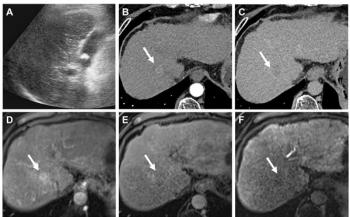
AI Improves and Reduces Time to Thyroid Nodule Diagnosis
Incorporating artificial intelligence with TI-RADS improves sensitivity, specificity, and reduces interpretation time by nearly one-fourth.
Adding an artificial intelligence (AI) tool that can assess the risk of malignancy in a thyroid nodule can not only improve accuracy, but it can lead to faster diagnoses, according to newly-published research.
In a poster presented during the Society for Imaging Informatics in Medicine (SIIM) 2021 Virtual Annual Meeting, Lev Barinov, Ph.D., vice president of medical applications and applied research at clinical decision support company Koios Medical shared research that showed including AI can lead to fewer unnecessary thyroid biopsies.
For more coverage of SIIM 2021, click
Thyroid nodules are common, affecting approximately 68 percent of people, and 95 percent of these findings are benign. Still more than 600,000 fine needle aspirations – a method that only roughly has 30-percent positive predictive value – occur annually. Implementing TI-RADS has reduced the rate of unnecessary biopsies by 19.9 percent to 46.5 percent, Barinov said, but the Koios Medical team wanted to see if it were possible to generate more improvement.
Based on their work, they developed an AI tool that can pre-populate TI-RADS descriptors to create a putative point total that readers can review and, potentially, use to modify their diagnostic decisions.
“Automated AI-based pre-population of the 5 TI-RADS descriptors combined with use of an additional AI-based risk descriptor and point modifier significantly improves reader diagnostic accuracy while simultaneously decreasing interpretation time and inter-reader variability,” he said.
To create the tool, the team had 15 readers (11 radiologists and four endocrinologists) review 650 nodules that were proven by fine needle aspiration twice across two sessions that were separated by four weeks. Of the group, 130 nodules were malignant. The readers randomly evaluated the nodules in one of two conditions – manual scoring of the TI-RADS report and AI-pre-populated TI-RADS report that was augmented by the AI tool and point modifier.
According to their analysis, adding the AI tool improved both sensitivity and specificity, as well as inter-reader variability. It also reduced interpretation time.
Specifically, the average area under the curve improvement for TI-RADS+AI and TI-RADs alone was 0.083, and TI-RADS+AI produced an 8.4-percent sensitivity increase and a 14-percent specificity boost. Inter-reader variability for TI-RADS and TI-RADS+AI was 0.622 and 0.876, respectively, and the time for interpretation dropped by 23.6 percent when readers used TI-RADS+AI, he said.
For more coverage based on industry expert insights and research, subscribe to the Diagnostic Imaging e-newsletter here .
Newsletter
Stay at the forefront of radiology with the Diagnostic Imaging newsletter, delivering the latest news, clinical insights, and imaging advancements for today’s radiologists.




























